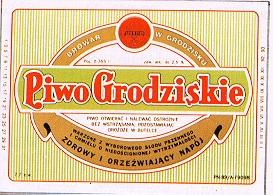
 Polish
Beer
Polish
BeerPoland may not be one of the first countries to spring to mind when thinking of beer, but it does have much in this sphere to warrant attention. It combines elements of the Czech, German and British traditions and even has a unique style of its own, the intriguing and obscure grodziskie beer.
The practice of brewing stretches well back into the middle ages, but it was in the 19th century when large-scale brewing began. At this time, as elsewhere in continental Europe, made ideas, techniques and machines were borrowed from the industrial breweries which were beginning to develop in Britain. The first beers produced in these new Polish breweries also originated in Britain; porter. As in many countries around the Baltic, this style gained popularity through exports from Britain in the late 19th century.
As bottom-fermenting techniques were developped elsewhere in Europe in the middle of the century, these were also adopted (not surprising at a time when large parts of present-day Poland were under German or Austrian rule), giving rise to pale lager beers. Porter, however, was never completely supplanted by these new beers and is still produced today. Beer production grew steadily up until the outbreak of the First World War, after which the state of Poland reappeared.
The economic crisis between the wars slowed the growth of the industry. On the eve of the German invasion in 1939 there were 137 breweries in operation. German occupation and war damage sent it into serious decline. It was was more than a decade after the end of the occupation that output was able to equal pre-war levels. Production increased from 3.33 million hectolitres in 1950 to 14.2 million hl in 1992.
Beer consumption has increased greatly from 26 litres per person in 1984 and is now around 40 litres. This is well below the level reached in most western European countries, but given another 10 years or so they should have caught up. On the other hand, consumption of spirits, at least from what I saw in pubs, has lost a lot of its popularity. And a good thing,too. Polish pubs could be a very depressing sight. Customers sitting by themselves with only a pair of 10cl glasses for company didn't make for a very cheerful atmosphere.

Currently, there are around 80 breweries active, including three micros founded in the 1990's. Beers are produced at a wide range of strengths, from 2.5% to 9.5% alcohol. Those at the higher end are more common that you might expect, but it's perhaps not quite so surprising when you consider the vodka-drinking tradition. In type, these are mostly pale lagers, though there are some dark lagers, too. Porters, in the strong Baltic style, are produced by a large number of breweries. These are around 22% balling or 9% alcohol, very dark brown to black in colour and with a sweet, rich flavour.
Lastly, there is the unique grodziskie beer, a top-fermenting smoked wheat beer, which was produced by a single brewery in the town of Grodzisk close to Poznan. Somehow this odd style managed to survive the conversion to bottom fermenting techniques and was a reminder of an older beer tradition. It didn't fare so well with the re-introduction of capitalism. The brewery making it was closed in a bout of "rationalisation" during the 1990's.
 Polish
Pubs
Polish
PubsMany things have changed in Poland since the late 1980's, not all of which have been improvements. With regard to pubs, the changes have most definitely been for the better.
Once it was difficult enough to find a pub of any kind, but finding one with draught beer was almost impossible. Fortunately, a large number of new pubs have appeared , with their trade based on the sale of draught beer. It's now no problem to find somewhere with five or six draught beers and a dozen bottled.
The inspiration for these new drinking establishments often appears to have been the British pub, though tha accuracy of the interpretation varies widely. Others are more on the lines of Czech boozers, which would seem a more sensible starting point, given the premises available for use.
One distinctive Polish trait is emerging and, while it may seem strange to us, it should be encouraged. This feature is the almost total darkness found inside. Sometimes, this is born of nesessity or convenience in bars buried in deep cellars or hidden in obscure outbuildings. In other cases, it is voluntary, where, in buildings with a perfectly good frontage on a street, the windows are carefully blacked out. Perhaps there is a certain lingering guilt about drinking and people prefer to do it under a cloak of darkness. Or it could be less complicated and be just a preference for the atmospheric affect of subdued lighting.
Something else worth noting about Polish pub culture, is the unusual age profile of the customers. In most countries, one of the largest groups of pub-users is always the under-30's, but the middle-aged, especially middle-aged men, are always well represented. In Poland it's rare to see anyone over 25 in a pub.
I can only assume that, because of the lack of anywhere to go in years goneby, older Poles have never got into the habit of going out drinking. It does lead to some odd experiences. Like entering a pub and finding that 80% of the customers are well-dressed, middle- class girls of 20 or less. That mainstay of pub life, the middle-aged male worker slurping down a few beers after his shift, barely gets a look in. However, as this whole phenomenon is very new, it will take it a while to settle down and assume its final form. After a few years, when the shine has gone off the new furniture and fittings, not everywhere will look as salubrious as it does now. Let's hope that variety, choice and a broadly-based group of customers win out.